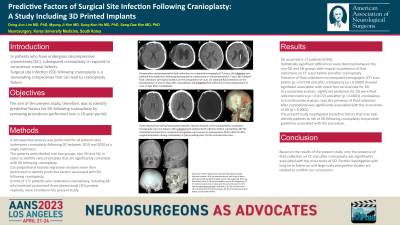Predictive Factors of Surgical Site Infection Following Cranioplasty Including 3D Printed Implants
Friday, April 21, 2023


Dong-Jun Lim, MD, PhD
Professor
Neurosurgery, Ansan Hospital, Korea University Medical Center
ePoster Presenter(s)
Introduction: In patients who have undergone decompressive craniectomy (DC), subsequent cranioplasty is required to reconstruct cranial defects. Surgical site infection (SSI) following cranioplasty is a devastating complication that can lead to cranioplasty failure. The aim of the present study was to identify predictive factors for SSI following cranioplasty.
Methods: A retrospective analysis was performed for patients who underwent cranioplasty following DC between 2010 and 2020 at a single institution. The patients were divided into two groups, non-SSI and SSI, in order to identify clinical variables that are significantly correlated with SSI following cranioplasty. Cox proportional hazards regression analyses were then performed to identify predictive factors associated with SSI following cranioplasty. A total of 172 patients who underwent cranioplasty, including 48 who received customized three-dimensional (3D) printed implants, were enrolled in the present study.
Results: SSI occurred in 17 patients (9.9%). Statistically significant differences were detected between the non-SSI and SSI groups with respect to presence of fluid collections on CT scans before and after cranioplasty. Presence of fluid collections on computed tomography (CT) scan before (p = 0.0114) and after cranioplasty (p < 0.0000) showed significant association with event-free survival rate for SSI. In a univariate analysis, significant predictors for SSI were fluid collection before (p = 0.0172) and after (p < 0.0001) cranioplasty. In a multivariate analysis, only the presence of fluid collection after cranioplasty was significantly associated with the occurrence of SSI (p < 0.0001).
Conclusion : The present study investigated predictive factors that may help identify patients at risk of SSI following cranioplasty and provide guidelines associated with the procedure. Based on the results of the present study, only the presence of fluid collection on CT scan after cranioplasty was significantly associated with the occurrence of SSI. Further investigation with long-term follow-up and large-scale prospective studies are needed to confirm our conclusions.
Methods: A retrospective analysis was performed for patients who underwent cranioplasty following DC between 2010 and 2020 at a single institution. The patients were divided into two groups, non-SSI and SSI, in order to identify clinical variables that are significantly correlated with SSI following cranioplasty. Cox proportional hazards regression analyses were then performed to identify predictive factors associated with SSI following cranioplasty. A total of 172 patients who underwent cranioplasty, including 48 who received customized three-dimensional (3D) printed implants, were enrolled in the present study.
Results: SSI occurred in 17 patients (9.9%). Statistically significant differences were detected between the non-SSI and SSI groups with respect to presence of fluid collections on CT scans before and after cranioplasty. Presence of fluid collections on computed tomography (CT) scan before (p = 0.0114) and after cranioplasty (p < 0.0000) showed significant association with event-free survival rate for SSI. In a univariate analysis, significant predictors for SSI were fluid collection before (p = 0.0172) and after (p < 0.0001) cranioplasty. In a multivariate analysis, only the presence of fluid collection after cranioplasty was significantly associated with the occurrence of SSI (p < 0.0001).
Conclusion : The present study investigated predictive factors that may help identify patients at risk of SSI following cranioplasty and provide guidelines associated with the procedure. Based on the results of the present study, only the presence of fluid collection on CT scan after cranioplasty was significantly associated with the occurrence of SSI. Further investigation with long-term follow-up and large-scale prospective studies are needed to confirm our conclusions.
